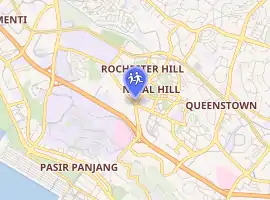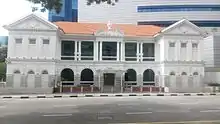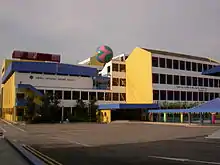Fairfield Methodist Schools
Fairfield Methodist School (Primary) and Fairfield Methodist School (Secondary) are two schools located on Dover Road. Founded in 1888 as the Anglo-Chinese Girls School,[1][2] they are among the oldest primary and secondary schools in Singapore. Their current premises are at the neighbourhood of Dover in Queenstown, Central Singapore.
| Fairfield Methodist Schools | |
|---|---|
_crest.jpg.webp) | |
| Location | |

| |
100 & 102 Dover Road, Singapore 139648 | |
| Coordinates | 1°18′0.511″N 103°47′6.785″E |
| Information | |
| Type | Government-Aided (Both); Autonomous (Sec only) |
| Motto | Pure and Honest |
| Religious affiliation(s) | Methodist |
| Established | 4 August 1888 |
| Session | Single (Day) |
| School code | 5020; 7309 |
| Principal | Mdm Law Li Mei (Primary); Ms Audrey Chen(Secondary) |
| Age range | 6 to 12; 12 to 16 |
| Enrolment | Approx. 1,500 (Primary); Approx. 2,000 (Secondary) |
| Colour(s) | Blue Yellow |
| Song | School Song School Hymn |
| Website | fmsp |

History
The Beginning
Miss Sophia Blackmore, a 32-year-old Australian missionary from the Methodist Women's Foreign Missionary Society,[3] had just established her first school in Singapore. Meanwhile, several influential Chinese families were persuading her to teach their daughters.[4][5] A widow later offered Blackmore her home along Cross Street for teaching.[6]
On August 1888, the Anglo-Chinese Girls' School began with just eight Peranakan girls.[7]
Contradicting accounts
However, there have been conflicting and differing stories on how the school really started, especially from the history book, Singapore: A Biography.[8]
According to the sources, Fairfield was started in August 1888 by Miss Sophia Blackmore, a 31-year-old missionary from the Methodist Mission. Her mandate in 1888 was to start a girls' school in Singapore in an enclave called Telok Ayer. She finally managed to start a class for eight Nonya girls in a little room at Cross Street. During that time, education for girls was definitely not favoured by the early traditional Chinese immigrants, even among the liberal-thinking Baba merchants.[9] Miss Blackmore then started going house to house, trying to persuade families to enroll their girls in her school. However, little by little, they suspected that she was a government spy sent to catch them secretly gambling at cards. They had started to pass the word that the young missionary lady was in fact a 'mati-mati' agent who was helping the British government enforce its new law against gambling.
Miss Blackmore's habit of asking for the women's names and writing them down in her notebook seemed to have alarmed the women. This was actually done as a record of who she visited, but still, the parents were suspicious of her. In spite of the differences and even suspicion from parents, Miss Blackmore persevered in her vision for a girls' school, and found that the parents were starting to welcome her more cordially, and would even invite her to sit down and chat over a cup of tea. They started to become more receptive to the idea that it would be good for their daughters to get a little education.
In June 1888, Miss Blackmore finally managed to get her first pupil. She recalls,
How pleased we were when one little girl, hearing of the school, clapped her hands and begged her mother to let her attend. She had been nicknamed 'Ganadolf', which means bald, because her head had been shaved during sickness. Not much knowledge entered that little bald head, but her own willingness to come to school helped others to decide.
After Ganadolf's mother agreed to send her daughter to school, a few other mothers followed her lead. Altogether, seven more pupils were signed on. Soon, she managed to rent out the front room of Nonya Boon, a rich widow's front room. The Anglo-Chinese Girls' School was finally founded.[10][11]
Early years
The school was soon renamed Telok Ayer Girl's School. It is a common misconception that it was the original name the school was founded as. However, it is currently unknown when the name change took place.
In 1893, the new principal, Emma Ferris,[12] found that the furniture had been removed because the landlady had decided to rent the room out to someone else to be used as a shop. She managed to find a new site for the school in a corner house along Telok Ayer Road. By then, the school had 30 students. In 1905, the school moved from the corner house at Telok Ayer into a larger house at Neil Road.
The principal, Miss Olson, realised that she required more space in the building and tried to raise funds for a new building. The biggest donation (US$5,000) came from a Mr James Fairfield from New England (patron of New England Branch of Women's Foreign Missionary Society or "WFMS").[13][14] This allowed the school to construct a new school building on a site provided by the government at Neil Road. The school moved from Telok Ayer into the new premises on Neil Road in 1912, and was promoted to a 'first-rate school' by the British Government. The relocated school was renamed Fairfield Girls' School.[15][16] By 1917, the growth of the school had forced a hundred Fairfield girls to study in a dark shophouse. In response to this, a new block extension was completed, consisting of six classrooms and a chapel hall in 1924.[17]
During the Japanese occupation of Singapore, the school was shut down. It only reopened in 1945.[18] Between 1942 and 1944, the school building was taken over by the Japan Military Force.[19]
In 1958 the school was renamed to Fairfield Methodist Girl's School.
On to Dover
_-_20051028.jpg.webp)
In 1983, the school moved to its current Dover campus to accommodate a larger population of students.[20] Concurrently, the school went co-educational, becoming the first Methodist School in Singapore to do so,[21] and became two separate schools, Fairfield Methodist Primary School and Fairfield Methodist Secondary School, each with its own administration, but still under the Fairfield Methodist School Board of Management. The schools also saw its first intake of boys as well.[22] Both schools remain housed in the same campus and share common facilities.
Fairfield (Primary)
To highlight the common history, heritage and close relationship of the Fairfield Methodist Schools, the name of the school was changed from Fairfield Methodist Primary School to Fairfield Methodist School (Primary), effective from January 2009.
Fairfield (Secondary)
Fairfield Methodist Secondary School was granted autonomous status in 1996, for its academic and co-curricular achievements. Like its Primary counterpart, the school was renamed Fairfield Methodist School (Secondary) in January 2009.
Buildings of Fairfield

Achievements
Fairfield Secondary
In 1987, Fairfield Methodist Secondary set up its Pioneer batch of The Boy's Choir, headed by Mrs Seet. There were no Girls Choir then.
87% of Sec 4 Express leavers were eligible for Junior College in 2007. The school achieved 76% distinctions in English Literature, compared with a national average of 37%, and 73% in Maths, compared with a national average of 55%.[23]
The number of pupils with 7 distinctions had also seen an increase from 17 in 2010 to 27 in 2011. The number of pupils with 8 distinctions had also increased from 4 in 2010 to 11 in 2011.[24] The school's Symphonic Band won a Gold award in the 2008 National Band Competition. Also in 2008, the school won Gold with Honours in the National Chinese Short Play competition, and 2nd prize in the Drama of History competition. The school's Boys Brigade won Gold in the JM Fraser Award for Excellence.[25] The school's choir won Gold in the SYF 2007.
Fairfield's English Drama had also won consecutive Gold with Honor's in the years 2009 and 2011, for their performances of Hamlet and Over the Wall.[26]
In 2008 FMSS received a special School Distinction Award from the Ministry of Education.[27] It has also been awarded the Best Practice Award (Teaching and Learning), the Outstanding Development Award (Character Development), and the Sustained Achievement Awards for Academic Value-Addedness, Uniformed Groups and Sports.[28]
The Fairfield Volleyball team is one of the most successful CCAs in the school. It had produced successful results since as long as more than 10 years ago. Led by coaches Tan Wee Ang and Lau Chun Tee, the current crop of Fairfield Volleyballers have achieved 2nd place in both the 'B division boys' and 'B division girls' categories in the south zone 2013. Additionally, the 'C division boys' were champions in the south zone as well and made it to 3rd place in the Nationals.
Service learning trips are also offered to students to their final destination. Destinations for these trips have been China, Nepal, India, Cambodia and Laos.
Notable alumni
Fairfield Primary
- Jamie Yeo: Celebrity
- Kit Chan: Singer
- Joshua Tan: Actor (Ah Boys to Men)
Fairfield Secondary
- Elim Chew: Entrepreneur; Founder, 77th Street street wear brand
- Cher Ng: Co-founder, Zouk, Kuala Lumpur, Malaysia; Founder, T.R.E.C, the largest entertainment zone in Malaysia
- Selena Tan: Actress
- Megan Zheng: Actress; First Singaporean to win a Golden Horse Award, the Chinese equivalent of the Oscars
- Steven Chia: Presenter; Mediacorp
- Kelvin Sng (Sun Liren): Director, producer
See also
References
- Singapore, National Library Board. "Sophia Blackmore | Infopedia". eresources.nlb.gov.sg. Retrieved 5 September 2016.
- SWHF. "SINGAPORE WOMEN'S HALL OF FAME – Sophia Blackmore". swhf.sg. Archived from the original on 11 September 2016. Retrieved 5 September 2016.
- Singapore, National Library Board. "Sophia Blackmore | Infopedia". eresources.nlb.gov.sg. Retrieved 3 September 2016.
- Tan, Ban Huat (3 January 1978). "Street talking: Tan Keong Saik". The Straits Times. Singapore. p. 6.
- "The Late Mr. Tan Keong Saik". The Straits Times. Singapore. 6 October 1909. p. 7.
- Singapore, National Library Board. "Sophia Blackmore | Infopedia". eresources.nlb.gov.sg. Retrieved 5 September 2016.
- "Portrait of Miss Sophia Blackmore, founder of Methodist Mission Girls' School – BookSG – National Library Board, Singapore". eresources.nlb.gov.sg. Retrieved 5 September 2016.
- Frost, Mark Ravinder; Balasingamchow, Yu-Mei (26 February 2013). Singapore: A Biography. Singapore: Didier Millet,Csi. ISBN 9789814385169.
- "Philanthropy in Transition: An Exploratory Study of Asian Women and Philanthropy in Singapore, 1900–1945" (PDF).
- Frost, Mark Ravinder; Balasingamchow, Yu-Mei. Singapore: A Biography.
- "Book preview: The education of Singapore girls". singaporebiography.com. Retrieved 5 September 2016.
- From Mission to Church: The Evolution of the Methodist Church in Singapore and Malaysia, 1885–1976.
- "Fairfield Methodist Girls' School | The Long and Winding Road". thelongnwindingroad.wordpress.com. Retrieved 5 September 2016.
- Earnest., Lau (2008). From mission to church : the evolution of the Methodist Church in Singapore and Malaysia, 1885–1976. Singapore: Genesis Books. pp. 98–99. ISBN 9789814222426. OCLC 228041073.
- "Former Fairfield Girls' School". roots.sg. Retrieved 5 September 2016.
- "Methodist School Brochure (October 2012)" (PDF).
- "CONSERVATION ABOUT BLAIR PLAIN (INCLUDES FORMER FAIRFIELD METHODIST GIRLS' SCHOOL)".
- "Our Story – Fairfield Methodist Church 卫理公会花菲教堂". fairfieldmc.org. Retrieved 3 September 2016.
- "Skylinep4b". ura.gov.sg. Retrieved 3 September 2016.
- The Straits Times (1 November 2013). "101-year-old Fairfield Girls' building gets total makeover". Retrieved 3 September 2016.
- "Fairfield Methodist Secondary School". eresources.nlb.gov.sg. Retrieved 7 September 2016.
- "SPEECH BY MR HO KAH LEONG, PARLIAMENTARY SECRETARY (EDUCATION), AT FAIRFIELD METHODIST SECONDARY SCHOOL'S 95TH ANNIVERSARY DINNER AT THE SHANGRI-LA ISLAND BALLROOM ON THURSDAY, 4 AUGUST 1983 AT 8.00 pm" (PDF).
- "'O' Level Report Card 2007". Archived from the original on 21 February 2009. Retrieved 14 April 2017.
- "Results of the 2011 GCE O- Level Examinations". Archived from the original on 9 April 2012. Retrieved 15 October 2012.
- "FMSS achievements page". Archived from the original on 21 February 2009. Retrieved 14 April 2017.
- "English Drama". Archived from the original on 25 December 2012. Retrieved 15 October 2012.
- Ministry of Education, School Information Service.
- Speech by Ms Grace Fu, Senior Minister of State Archived 22 May 2012 at the Wayback Machine, at the FMSS 120th Founder's Day Service, 1 August 2008.
External links
- School website
- School leaders
- Neil Road (Article)
- A walk down Neil Road
- Exhibition on women pioneers to open on Thursday at the National Museum
- [1]
- [2]
- [3]
- [4]
- [5]
- Official website
- Diana Chee-Chung, "Treats from the Fairfield Story".
- Methodist Schools' Foundation
- Speech by Ms Grace Fu, Senior Minister of State, Ministry of National Development & Ministry of Education, at the FMSS 120th Founder's Day Service, 1 August 2008.
- The Methodist Girls' School Alumnae presents a night at the opera with the stars of the New York Metropolitan Opera.
- https://www.peranakan.org.sg/magazine/2000/2000_Issue_3.pdf. External link in
|title=(help) - Sng, Bobby E.K. In His good time : the story of the church in Singapore, 1819-2002.
- Singapore : the encyclopedia.
- Sophia Blackmore in Singapore : educational and missionary pioneer, 1887-1927. General Conference Women's Society of Christian Service, Methodist Church of Singapore. 1987. ISBN 9971847485.